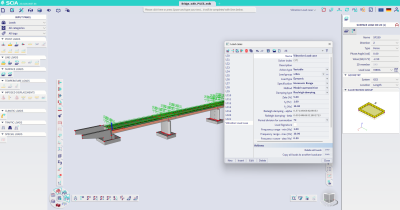Highlights
- Steady-State Harmonic analysis given a single frequency or a range of frequencies
- Nodal, Line and Surface harmonic loads
- In-phase and out-of-phase harmonic loads
- Rayleigh and Constant Damping
- Peak and RMS Accelerations, Velocities and Displacements among the results
- Automatic Load Signature based on selected modal shape
Vibration Analysis, what is it
Vibration analysis is a critical aspect of civil engineering that focuses on understanding and controlling how structures respond to dynamic forces. Civil structures such as buildings, bridges, and towers are subject to various vibrational forces from sources like wind, traffic, machinery, and human activity. Vibration analysis helps engineers evaluate how these forces affect the stability, safety, and performance of the structure. This analysis is particularly important in ensuring that structures do not experience excessive vibrations, which could lead to discomfort, damage, or even failure. By controlling vibrations and avoiding resonance, vibration analysis helps engineers design safer, more reliable, and more comfortable structures, making it an essential practice in modern civil engineering.
Vibration Analysis in SCIA Engineer
The new SCIA Engineer vibration analysis module allows to apply nodal, line and surface harmonic loads. The harmonic loads can be in-phase and out-of-phase.

The computation can be performed specifying a single frequency of interest or a range of frequency to be analyzed. Constant and Rayleigh Damping can be used.

Furthermore, the sign of the harmonic load can be given according to a specific modal shape, so to quickly reproduce worst-case-scenario loading as specified by several buildings and bridges design guidelines (for instance, SETRA [Service d'études techniques des routes et autoroutes] design guide for Footbridges).

Other than standard results, acceleration, velocity and displacement are available in the newly introduced and specific “Dynamic Detailed results” menu, both as peak and RMS values.

Required modules:
- Modal Analysis (sens.10)

Want to try SCIA Engineer yourself?
Explore how our software and services can help you optimise your work and boost your productivity. Try it for yourself with a free 30-day software trial.
Download a free 30-days full trial